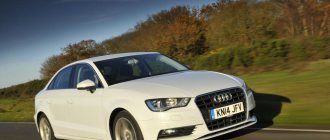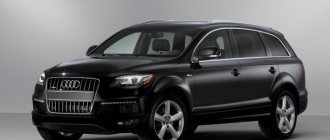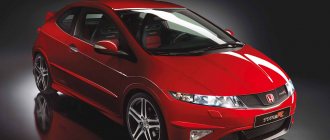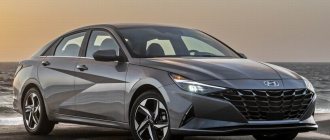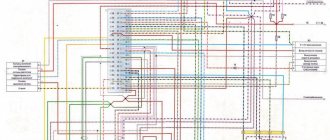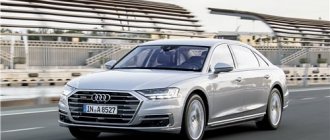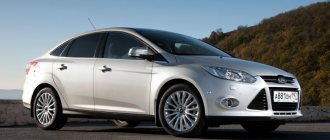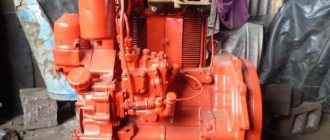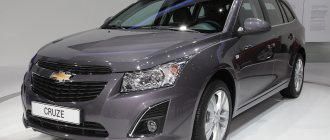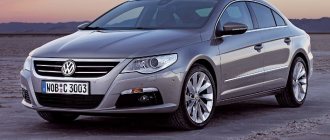The Audi 100 45 body is a legendary German car, which was considered a very desirable car in its day. Now these cars still exist, but they are few and far between, and they are rarely found in good condition, but there are people who love their cars and look after them and service them on time. The Audi 100 45 body was produced from 1990 to 1994. After 1994 and until 1996, this body remained the same, only the car began to be called Audi A6 C4. And a little later, the Audi A6 C5 appeared, tuning of which is done very often.
The Audi 100 in the 45 body was a popular car in its time; approximately 600,000 cars of this model were produced. After 1995, the Audi 100 became known as the Audi A6. In those years, as now, the main competitors were BMW and Mercedes. Moreover, in terms of quality and reliability, the Audi 100 remained on par with the BMW 5 and Mercedes E-Class.
Engines in Audi 100 45 body
The range of engines for the Audi 100 45 body was quite wide. The most basic engine was considered to be a 101-horsepower gasoline engine with a volume of 2 liters; there were also more powerful engines with a volume of 2.3 liters and a power of 133 liters. With. and 2.8 liters with a power of 174 hp. With.
In 1991, a 2-liter gasoline engine with a power of 115 hp was added. With. and 2 diesel engines: 2.4 liters with a power of 82 hp. s and 2.5 liters with a power of 115 hp. With.
At that time, the top-end engine was a 2.2 liter engine with a power of 230 hp. With. The transmission could be either a 4-speed automatic or a 5-speed manual.
Model specifications
What was remarkable about the A6 sedan and 100 Avant was not only the magnificent 45 body, but also the variety of power units. Engine models have changed most frequently since 1994. Then the car was equipped with:
- 8 MT, AT, quatro MT;
- 9 TDI MT, AT;
- 0 MT;
- 0E MT, AT, quatro MT;
- 3 MT, quatro MT, AT;
- 5 TDI MT, quatro MT, AT;
- 6 MT, quatro MT, AT, quatro AT;
- 8 MT, quatro MT, AT, quatro AT.
Such diversity attracted car enthusiasts to this car, but most continued to call the Audi A6 with a 45 body “one hundred”. The engines were diesel and gasoline, equipped with 4 and 5 speed gearboxes.
In front of the Audi 100 in the 45 body
The most popular version of the A6 was the one that was given a 2.3-liter gasoline engine. Its characteristics were as follows:
- fuel consumption from 7 to 12.5 liters per 100 km, depending on conditions;
- naturally aspirated engine – 133 hp. With.;
- acceleration to 100 km/h in 10.2 s;
- efficient cooling system running on a mixture of water and antifreeze;
- 5 cylinders;
- mechanical fuel injection.
Read also All useful information about the Audi Q3 car line
This version of the 1994-95 Audi A6 is still relevant. Such cars are taken away very quickly, since with a relatively small initial investment, they are able to operate for a long time without maintenance.
Surprisingly, the Audi A6, produced in this old body, was well equipped. In 1995, it was chosen for its ABS, airbags and heated front seats. It was a fairly high-quality business class with everything you need on board. For this reason, the car does not lose its relevance among classic lovers.
Tuned Audi 100 in 45 body
Appearance of Audi 100 45 body
The dimensions of the Audi 100 45 body are really large, so there is plenty of space in the cabin. 5 people can move around in comfort. The seats are comfortable, with lateral support. The trunk is large, there is also an Audi 100 station wagon, so there is even more space. You can safely place a person in the trunk of a sedan and he will lie there quite comfortably.
What Audi bodies are famous for is the fact that their body is perfectly protected from corrosion, because the body is made of aluminum, so if the car has not been in an accident, then its body will be in excellent condition even after 20 years. Officially, Audi guarantees against through corrosion for 10 years. The build quality is at a high level, the sound insulation is also excellent even after all these many years.
Technical characteristics of the Audi 100 C3
| Model year | 1982 |
| Body type | Sedan |
| Length, mm | 4793 |
| Width, mm | 1814 |
| Height, mm | 1422 |
| Number of doors | 4 |
| Number of seats | 5 |
| Trunk volume, l | 570 |
| Country of assembly | Germany |
Salon
The salon is made according to German traditions, the materials are of high quality, everything is adjusted and assembled to a high standard. Over time, of course, squeaks and knocking noises may appear, but this applies to any old car. Depending on the configuration, there is leather trim and velor trim.
While driving, you feel that the suspension has a sporty touch, you feel that it is stiff, but if you drive on a normal road, it will be comfortable. But at high speeds the car behaves confidently, steers well, and when the speed increases, the Audi 100 becomes a little closer to the road to improve stability.
What is included in the Audi 100 45 body package
Even in the early 90s, the car already had the following options:
- ABS system;
- radio with speakers;
- air conditioner;
- on-board computer;
- electric windows;
- airbags;
- heated front seats;
- heated mirrors.
Tuning Audi 100 45 body
Still, in 2021, the youngest copy of the Audi 100 45 body will turn 23 years old, so the car clearly does not look modern. Therefore, if you tune the Audi 100 45 body, the car will look much more interesting. You can tint the car yourself or stick on different sports stickers.
You can also install original bumpers, a more aggressive radiator grille, a spoiler or a wing attached to the trunk. The trims can also be placed on the hood or sill; they look impressive. Even while tuning the Audi 100 45 body, the headlights are changed and the interior is improved; you can reupholster it with new leather.
But for those who like everything in the car to be original, you don’t have to do any tuning, just touch up the problem areas and polish the car yourself, then the car will look great. It is not difficult to find spare parts for it now, since it is a fairly popular machine, so if it is seriously repaired once, it will serve for a long time.
Body
Due to age, the paintwork may have defects. In addition, corrosion may be present. Despite the fact that the body of the car in question is well protected from it, there are also critical places from this point of view, which are the front fenders. The method of restoring the paintwork is repainting. These works should be combined with rust removal. Repainting can be considered as external tuning of the Audi 100 (45 body), since it is associated with a change in the appearance of the car. If you have the appropriate equipment, it is quite possible to carry out this work yourself.
In addition, you can cover the body with film. This tuning of the Audi 100 (45 body) has various functions depending on the type of material used. There are protective and vinyl films. Materials of the first type are much stronger, but not as elastic. Therefore, they are applied to parts that are most susceptible to chipping, such as the front bumper and the hood edge. This allows you to protect the paintwork, ensuring its durability. Vinyl films, as well as repainting, can be considered as external tuning of the Audi 100 (45 body). This is explained by the fact that, due to their low strength, they can provide the body with protection only from weak impacts. However, the material is so elastic that it allows you to cover the entire body. In addition, there are many options for such films, differing in color and texture. At the same time, applying the film is easier than repainting.
In addition, you can replace hanging elements (lighting fixtures, bumpers, mirrors, etc.). This allows you to significantly change the design of the car.
Replacing bumpers is quite simple. To do this, you need to select a part that is suitable in size. Due to the design and image features, tuning of the Audi 100 (45 body) bumper is usually not done using massive body kits.
A very simple and functional way to modify a car body is to replace the headlights. This allows you to equip it with xenon, bi-xenon or LED headlights. These transformations can be made in two ways: install new lighting equipment in the original headlight housings or select non-standard headlights for the Audi 100 (45 body). Tuning of this kind requires subsequent adjustment of the lighting fixtures, otherwise it will be ineffective and, on the contrary, will most likely lead to a decrease in the original qualities. Moreover, the adjustment must be carried out by specialists using appropriate equipment.
One of the simplest tuning methods is tinting. It is also possible to apply the film on glass yourself without the use of specialized equipment. Using a moderately dark tint will transform the design of the car, protect its interior from the sun, while maintaining a sufficient level of visibility.
If there are doubts about how harmonious the Audi 100 (45 body) will look with any type of external changes, tuning photos will help you evaluate this.
Audi 100/45 review
“Sotka” in the 45 body is often called a “cigar” - it received this name due to its elongated, rounded body. In general, the car is not designed for fast driving - if you constantly “fire” it, the suspension will quickly fail. Accordingly, the car is not designed for use on country roads; the Audi 100/45 is a typical city “resident”. But the suspension itself is soft, does not tire on bumps, the car drives confidently and handles well.
The interior of the car is quite comfortable:
- The seats are comfortable to sit in for both the driver and all passengers - front seats with lateral support;
- there is a lot of space in the cabin, the roof above your head is high, even the tallest passengers can comfortably fit on the seats;
- The instrument panel is informative and ergonomic - there are no unnecessary buttons, and they are all in their places.
The sound insulation of the interior is very good - it is carefully glued, and with a fairly thick layer, not like in Japanese brands, not to mention Russian VAZs.
The car body is completely galvanized, and if the car has not been in a serious accident, it will not rust. Fuel consumption and dynamics depend on the type of engine installed; engines also do not cause much trouble for car owners.
Characteristics of the Audi 100 C3
Main characteristics of the Audi 100 C3 sedan.
| Characteristic | sedan 100 C3 | sedan 100 C3 restyling |
| Years of production | 1982-1988 | 1988-1990 |
| Category | E | E |
| Body | sedan | sedan |
| Length, mm | 4790 | 4790 |
| Width, mm | 1810 | 1810 |
| Height, mm | 1420 | 1420 |
| Wheelbase, mm | 2690 | 2690 |
| Ground clearance, mm | 130 | 133 |
| Front track, mm | 1470 | 1480 |
| Rear track, mm | 1470 | 1480 |
| Weight, kg | 1059 | 1080 |
| Tank volume, l | 80 | 80 |
| Trunk volume, l | 570 | 570 |
| Number of doors | 4 | 4 |
| Number of seats | 5 | 5 |
Main characteristics of the Audi 100 C3 Avant station wagon.
| Characteristic | Avant 100 C3 | Avant 100 C3 restyling |
| Years of production | 1982-1988 | 1988-1990 |
| Category | E | E |
| Body | station wagon | station wagon |
| Length, mm | 4790 | 4790 |
| Width, mm | 1810 | 1810 |
| Height, mm | 1420 | 1420 |
| Wheelbase, mm | 2690 | 2690 |
| Ground clearance, mm | 133 | 133 |
| Front track, mm | 1470 | 1480 |
| Rear track, mm | 1470 | 1480 |
| Weight, kg | 1130 | 1130 |
| Tank volume, l | 80 | 80 |
| Trunk volume, l | 644 | 644 |
| Number of doors | 5 | 5 |
| Number of seats | 5 | 5 |
Modifications of the Audi 100 C3 sedan.
| Engine type and volume, l | Power, l. With. | Transmission | Drive unit |
| petrol, 1.8 AT | 90 | Automatic transmission | front |
| petrol, 1.8 quattro MT | 90 | Manual transmission | full |
| petrol, 1.8 MT | 75 | Manual transmission | front |
| petrol, 1.8 MT | 90 | Manual transmission | front |
| petrol, 1.9 AT | 100 | Automatic transmission | front |
| petrol, 1.9 MT | 100 | Manual transmission | front |
| diesel, 2.0 D AT | 70 | Automatic transmission | front |
| petrol, 2.0 AT | 115 | Automatic transmission | front |
| diesel, 2.0 TD AT | 87 | Automatic transmission | front |
| diesel, 2.0 TD MT | 87 | Manual transmission | front |
| diesel, 2.0 D MT | 70 | Manual transmission | front |
| petrol, 2.0 MT | 115 | Manual transmission | front |
| petrol, 2.1 AT | 136 | Automatic transmission | front |
| petrol, 2.1 MT | 136 | Manual transmission | front |
| petrol, 2.2 T AT | 165 | Automatic transmission | front |
| petrol, 2.2 AT | 138 | Automatic transmission | front |
| petrol, 2.2 quattro MT | 138 | Manual transmission | full |
| petrol, 2.2 T quattro MT | 165 | Manual transmission | full |
| petrol, 2.2 MT | 138 | Manual transmission | front |
| petrol, 2.2 T MT | 165 | Manual transmission | front |
| petrol, 2.3 AT | 136 | Automatic transmission | front |
| petrol, 2.3 MT | 136 | Manual transmission | front |
| petrol, 2.3 quattro MT | 136 | Manual transmission | full |
| diesel, 2.4 D MT | 82 | Manual transmission | front |
| diesel, 2.5 TDI MT | 120 | Manual transmission | front |
Modifications of the Audi 100 C3 in the Avant station wagon.
| Engine type and volume, l | Power, l. With. | Transmission | Drive unit |
| petrol, 1.8 AT | 90 | Automatic transmission | front |
| petrol, 1.8 MT | 75 | Manual transmission | front |
| petrol, 1.8 MT | 90 | Manual transmission | front |
| petrol, 1.8 quattro MT | 90 | Manual transmission | full |
| diesel, 2.0 D AT | 70 | Automatic transmission | front |
| diesel, 2.0 TD AT | 87 | Automatic transmission | front |
| petrol, 2.0 AT | 115 | Automatic transmission | front |
| petrol, 2.0 MT | 115 | Manual transmission | front |
| diesel, 2.0 TD MT | 87 | Manual transmission | front |
| diesel, 2.0 TD MT | 100 | Manual transmission | front |
| diesel, 2.0 D MT | 70 | Manual transmission | front |
| petrol, 2.2 AT | 138 | Automatic transmission | front |
| petrol, 2.2 T AT | 165 | Automatic transmission | front |
| petrol, 2.2 MT | 138 | Manual transmission | front |
| petrol, 2.2 quattro MT | 138 | Manual transmission | full |
| petrol, 2.2 T quattro MT | 165 | Manual transmission | full |
| petrol, 2.2 T MT | 165 | Manual transmission | front |
| petrol, 2.3 AT | 136 | Automatic transmission | front |
| petrol, 2.3 MT | 136 | Manual transmission | front |
| petrol, 2.3 quattro MT | 136 | Manual transmission | full |
| diesel, 2.4 D MT | 82 | Manual transmission | front |
| diesel, 2.5 TDI MT | 120 | Manual transmission | front |
Return to content
Audi 100 45 technical specifications
The Audi 100/45 C4 was produced in two body styles:
The trunk is spacious even in a sedan, not to mention a station wagon. The luggage compartment is not just long, it is also quite deep and wide, as they say, there is room in it - an entire carriage.
The range of power units on the Audi 100 is very extensive - the car was equipped with gasoline engines:
- four-cylinder 2.0 l;
- five-cylinder 2.3 l;
- six-cylinder 2.6 and 2.8 liters;
- eight-cylinder 4.2 liters.
The cars were also equipped with diesel engines with volumes of 2.4 and 2.5 liters, transmissions on the Audi 100/45 of two types:
The Audi 100 45 sedan has the following technical characteristics:
- number of seats in the cabin – 5 (including the driver);
- dimensions (length/width/height) – 4.79/1.77/1.43 m;
- distance between wheel axles – 2.69 m;
- luggage compartment volume – 510 l;
- ground clearance – 13 cm;
- radius of standard rims – R15;
- fuel tank, volume – 80 l;
- curb weight - 1.4 tons.
Fuel consumption directly depends on engine size, and the difference can be very large. For example, with a 2.0 liter engine, an Audi 100/45 on the highway should meet the norm of 7.8 l/100 km, and with a 4.2 engine it can consume 16 liters of gasoline or more in the city. Fuel consumption also largely depends on:
- on driving style;
- transmission types (“automatic” or “manual”);
- wheel drive (front or full).
History of Audi 100 C3 (44 body)
The full-size Audi 100 C3 sedan was produced from 1982 to 1990. It was first presented at the Frankfurt Motor Show. Audi constructors and designers were able to create at that time a truly economical, spacious and comfortable car. The Audi 100 C3 was equipped with a spacious trunk, the volume of which was 570 liters. The car could easily carry five passengers plus 175 additional kilograms of cargo. The Audi 100 C3 sedan appeared on the market almost immediately, and a little later the Avant station wagon.
According to owner reviews, the Audi 100 C3 has high handling. The car holds a straight line perfectly, accurately follows the turning trajectory, and is resistant to skidding. Most third-generation Audi 100s in the 44 body were produced with front-wheel drive, but there were also Quattro all-wheel drive modifications. The basic versions of the Audi 100 C3 did not have power steering. This makes it difficult to spin the wheels in a parking lot, but there is no extra unit that requires repair.
A modification of the Audi 100 C3 in the Avant station wagon was released in March 1983. The car received a rather flat rear door, which reduced air flow turbulence and improved aerodynamic characteristics. The aerodynamic drag coefficient of the body is 0.34. In addition, this solution significantly reduced contamination of the rear door glass. At the same time, the trunk volume was 1800 liters.
At the beginning of 1985, a version of the Audi 100 C3 with Quattro all-wheel drive was released. At the same time, Audi engineers developed a longitudinal layout of the engine in the engine compartment. The Avant Audi 100 C3 Quattro all-wheel drive station wagon was a great success on the market. It was in demand among travelers and people who preferred to go out into nature as a recreation.
Audi 100 cars in the 44 body on the European market were offered with a large selection of 4 and 5 cylinder engines. The most popular were four-cylinder models with a volume of 1.8 liters. Among the gasoline engines there were models with both a carburetor and an injector. Carburetor models with a power of about 90 horsepower consumed 10.7 liters of gasoline per 100 kilometers in the urban cycle. Such engines were distinguished by their reliability and simplicity of design. In 1988, the Audi 100 C3 was restyled, during which the engine line was modernized. New models have become more powerful, but at the same time, more demanding on maintenance, fuel and oil.
Representatives of the family of injection engines had a volume from 2 to 2.3 liters and a power from 100 to 133 horsepower. They were as reliable as carburetor ones, but their repairs were much more expensive. Beginning in 1986, Audi 100 cars in the 44 body began to be equipped with economical five-cylinder diesel engines with a volume of 2 liters. In addition, a series of turbocharged diesel engines appeared, the power of which ranged from 69 to 100 horsepower. Somewhat later, a 2.5 liter diesel engine with a capacity of 120 horsepower was released. It is also worth noting that the restyled Audi 100 C3 models have 2.2-liter engines with output of 165 and 220 horsepower, released in 1989. The full list of modifications of the Audi 100 C3 in body 44 can be found in the next section of the article called characteristics.
Audi 100 C3 before restyling in a sedan body
There was also a 2.1-liter gasoline injection engine with an output of 182 horsepower, which was installed on the model
Audi 200
.
The Audi 200 modification was made in the same 44 body. It was distinguished from the “hundred” by smaller headlights, chrome trim on the front panel, and the presence of wood veneer and leather trim in the interior.
Audi 100 C3 cars produced after 1985 have a fully galvanized body, door and sill plates, and branded fender liners. If, when buying a car on the secondary market, you see rust on the body where there is no damage, it means that the Audi 100 C3 was produced before 1985.
It is also worth noting the Audi 5000 model in 44 body. These sedans were sold in the American market between 1983 and 1988. They mainly differed in the level of basic equipment. In particular, the car had electric windows, 4 headlights, a sunroof, adjustable mirrors, an automatic transmission, air conditioning, and an exhaust converter. The Audi 5000 model was adjusted to the fuel consumption and emissions standards of US legislation. Since 1989, the Audi 100 and 200 models have been sold in the US market under their original names, since by that time they had already earned a positive image for themselves.
Restyling of the Audi 100 C3, carried out in 1988, brought the following changes:
- The body received smoother lines;
- The door handles have become somewhat more recessed;
- The instrument panel has been updated;
- The chrome plating was removed from the edging of the rear headlights, side moldings, and bumpers;
- After restyling, all gasoline power plants receive an adjustable neutralizer.
In 1989, the Avant Audi 100 sedan and station wagon entered the market in a 44 body with a 2.3-liter engine and an output of 138 horsepower. The Audi 100 C3 was discontinued at the end of 1990. The car is being replaced by the fourth generation Audi 100 C4. From that moment on, the Audi 200 modification was no longer produced. In the vastness of the former USSR, there are still quite a few Audi 100 C3s running around, mostly restyled ones. Read about their operation, reviews from owners and weak points in the operation section, and now let’s look at the characteristics and modifications of the Audi 100 C3.
Return to content
